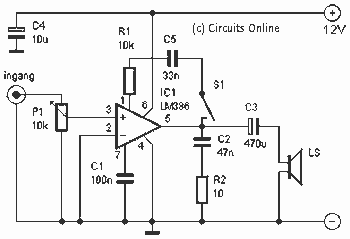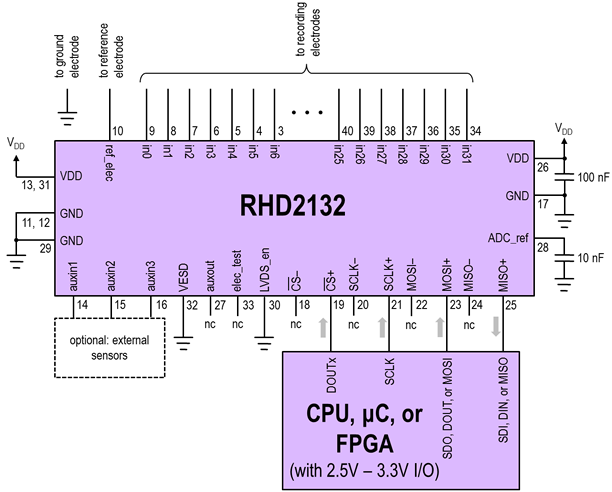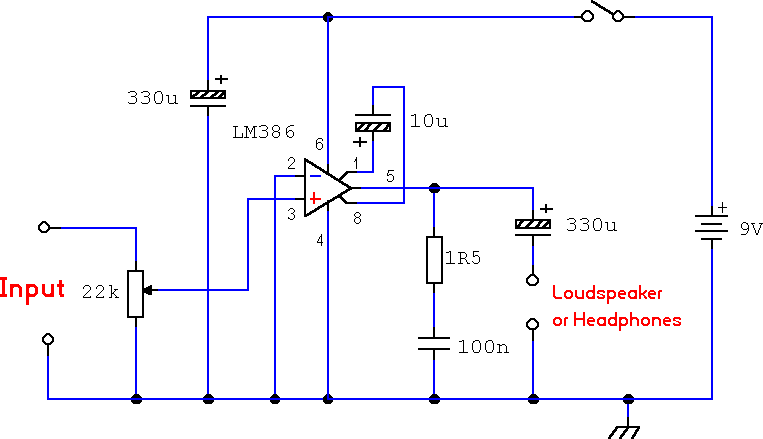
1 Watt amplifier using LM386

This circuit is a signal line so that you reinforce with a small speaker can control. The LM 386 is a number of versions available. LM 386N-1 can provide a power of 325 mW, the LM-386N 2500 mW, the LM-386N 3700 386N mW and the LM-4 to 1 watt power supply. All versions can be used in the circuit. Using S1 is a bass boost (extra bass enhancement) lamp. In the drawn state, the bass boost off. More: Parts List R1 = 10 kOhm R2 = 10 ? P1 = 10 kOhm C1 = 100 nF C2 = 47 nF C3 = 470 uF C4 = 10 uF C5 = 33 nF IC1 = LM 386 S1 = Switch
The described circuit utilizes the LM386 audio amplifier IC, which is well-regarded for its versatility and efficiency in driving small speakers. The circuit is designed to amplify audio signals, making it suitable for applications requiring sound reinforcement. The LM386 is available in several variants, with the LM386N-1 providing 325 mW, the LM386N offering 500 mW, and the LM386N-3 capable of delivering up to 700 mW. The LM386N-4 version can output up to 1 watt, allowing for flexibility in power requirements based on the application.
The circuit employs a few essential components, including resistors, capacitors, and a switch for bass enhancement. The resistors R1 and R2, both rated at 10 kOhm, serve to set the gain of the amplifier and establish the input impedance. The potentiometer P1, also 10 kOhm, allows for user-adjustable gain, enhancing the circuit's usability in varying audio environments.
Capacitors C1, C2, C3, C4, and C5 are crucial for filtering and coupling. C1, with a value of 100 nF, is likely used for input coupling to block any DC offset from the signal source. C2, at 47 nF, may serve a similar function or be used for frequency response shaping. The larger capacitor C3, rated at 470 µF, is employed for power supply decoupling, ensuring stable operation of the amplifier by smoothing out fluctuations in the supply voltage. Capacitor C4 (10 µF) might be used for additional decoupling or signal coupling, while C5 (33 nF) can be involved in frequency response adjustment, particularly affecting the bass response.
The switch S1 is integrated into the circuit to enable or disable the bass boost feature. When the switch is in the "off" position, the bass enhancement is disabled, allowing for a more neutral sound profile. When engaged, this feature enhances the low-frequency response, making it particularly useful for applications that require a richer bass output, such as music playback or sound effects in multimedia applications.
Overall, this circuit exemplifies a straightforward yet effective design for audio amplification, leveraging the LM386's capabilities and a minimal component count to achieve desired sound reinforcement outcomes.This circuit is a signal line so that you reinforce with a small speaker can control. The LM 386 is a number of versions available. LM 386N-1 can provide a power of 325 mW, the LM-386N 2500 mW, the LM-386N 3700 386N mW and the LM-4 to 1 watt power supply. All versions can be used in the circuit. Using S1 is a bass boost (extra bass enhancement) lamp. In the drawn state, the bass boost off. Parts List R1 = 10 kOhm R2 = 10 ? P1 = 10 kOhm C1 = 100 nF C2 = 47 nF C3 = 470 uF C4 = 10 uF C5 = 33 nF IC1 = LM 386 S1 = Switch 🔗 External reference
The described circuit utilizes the LM386 audio amplifier IC, which is well-regarded for its versatility and efficiency in driving small speakers. The circuit is designed to amplify audio signals, making it suitable for applications requiring sound reinforcement. The LM386 is available in several variants, with the LM386N-1 providing 325 mW, the LM386N offering 500 mW, and the LM386N-3 capable of delivering up to 700 mW. The LM386N-4 version can output up to 1 watt, allowing for flexibility in power requirements based on the application.
The circuit employs a few essential components, including resistors, capacitors, and a switch for bass enhancement. The resistors R1 and R2, both rated at 10 kOhm, serve to set the gain of the amplifier and establish the input impedance. The potentiometer P1, also 10 kOhm, allows for user-adjustable gain, enhancing the circuit's usability in varying audio environments.
Capacitors C1, C2, C3, C4, and C5 are crucial for filtering and coupling. C1, with a value of 100 nF, is likely used for input coupling to block any DC offset from the signal source. C2, at 47 nF, may serve a similar function or be used for frequency response shaping. The larger capacitor C3, rated at 470 µF, is employed for power supply decoupling, ensuring stable operation of the amplifier by smoothing out fluctuations in the supply voltage. Capacitor C4 (10 µF) might be used for additional decoupling or signal coupling, while C5 (33 nF) can be involved in frequency response adjustment, particularly affecting the bass response.
The switch S1 is integrated into the circuit to enable or disable the bass boost feature. When the switch is in the "off" position, the bass enhancement is disabled, allowing for a more neutral sound profile. When engaged, this feature enhances the low-frequency response, making it particularly useful for applications that require a richer bass output, such as music playback or sound effects in multimedia applications.
Overall, this circuit exemplifies a straightforward yet effective design for audio amplification, leveraging the LM386's capabilities and a minimal component count to achieve desired sound reinforcement outcomes.This circuit is a signal line so that you reinforce with a small speaker can control. The LM 386 is a number of versions available. LM 386N-1 can provide a power of 325 mW, the LM-386N 2500 mW, the LM-386N 3700 386N mW and the LM-4 to 1 watt power supply. All versions can be used in the circuit. Using S1 is a bass boost (extra bass enhancement) lamp. In the drawn state, the bass boost off. Parts List R1 = 10 kOhm R2 = 10 ? P1 = 10 kOhm C1 = 100 nF C2 = 47 nF C3 = 470 uF C4 = 10 uF C5 = 33 nF IC1 = LM 386 S1 = Switch 🔗 External reference




